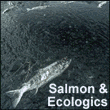forum
library
tutorial
contact

Officials Fall Short of Salmon Return Goals in
Columbia River Basin But See Signs of Progress
by Mia Maldonado
Washington State Standard, December 13, 2024
|
the film forum library tutorial contact |

|
Officials Fall Short of Salmon Return Goals in
by Mia Maldonado
|
37 years later, council remains far from goal of 5 million fish returns
 Officials are still not close to reaching their goal of returning at least 5 million salmon and steelhead to the Columbia River Basin. However, new data shows a positive trend in total abundance of fish in the basin.
Officials are still not close to reaching their goal of returning at least 5 million salmon and steelhead to the Columbia River Basin. However, new data shows a positive trend in total abundance of fish in the basin.
That's according to the Northwest Power and Conservation Council, which on Tuesday met over Zoom to discuss the latest data of salmon and steelhead populations in the Columbia River Basin.
Before 1850, salmon and steelhead runs to the Columbia River Basin were estimated to have been between 10 to 16 million annually. Dams significantly fractured those runs, and in the 1990s, runs declined to about 1 million a year.
However, the most recent 10-year rolling average from 2014-2023 stands at 2.3 million salmon and steelhead returning to the basin, similar to the average of 2.4 million fish between 2004-2013, and an improvement from the average in the 1990s which fell to 1.3 million fish, according to data from the council.
"Increased salmon and steelhead abundance in the Columbia River Basin -- especially above Bonneville Dam -- over the past 40 years marks important progress," Council Member Louie Pitt, who represents Oregon and is a member of the Confederated Tribes of the Warm Springs, said in a press release.
The Northwest Power and Conservation Council was established in 1980 by the Northwest Power Act, which authorized Idaho, Montana, Oregon and Washington to develop a program to protect, mitigate and enhance fish and wildlife impacted by hydropower systems in the Columbia River Basin.
The council's fish and wildlife program is funded by the Bonneville Power Administration, and it directs more than $280 million annually to cover 300 projects throughout the basin.
In 1987, the council set a goal to have 5 million salmon and steelhead return to the basin past Bonneville Dam by 2025. And through the 1990s, 12 salmon and steelhead populations in the Columbia River Basin were listed for protection under the Endangered Species Act as run sizes continued to decline.
Since then, the closest the council has been to reaching its 5 million goal was in 2014, when 4.6 million salmon and steelhead returned to the basin.
While dams are a primary hindrance to salmon and steelhead population recovery, these fish also face severe stresses from climate change, pressures from human population growth in the basin, and other environmental impacts, Pitt said.
"We cannot ease up in our collective efforts to help these fish populations grow stronger and larger everywhere we can -- including in blocked areas of our basin such as above Chief Joseph and Grand Coulee dams," Pitt said.
Ed Schriever, a council member who represents Idaho and is a former director of the Idaho Department of Fish and Game, said the progress is a result of the coordination between state, federal and tribal agencies and other partners across the Columbia River Basin.
"Over the past four decades the region's fish and wildlife managers have significantly increased their capacity to perform mitigation, stewardship, and enhancement," Schriever said in the press release. "The managers have also refined their methods and processes as our scientific understanding has evolved and grown more sophisticated. The work being done today is more directed and purposeful than it has ever been."
Data shows improvement in fish production above Bonneville Dam
Another key finding from Tuesday's presentation is an improvement in salmon and steelhead production above Bonneville Dam since the establishment of the council Endangered Species Act listings.
Early initiatives of the 20th century to recover salmon and steelhead populations, such as hatcheries, focused mostly in the lower sections of the Columbia River to benefit commercial fisheries and ocean harvest, said Peter Jensen, council spokesperson. This ignored fisheries upstream, particularly those for tribes, which experienced the heaviest losses of salmon and steelhead abundance.
Since then, new hatcheries upstream of Bonneville Dam, many managed or co-managed by tribes, have helped offset some of those losses.
The data presented on Tuesday gives a more complete picture of salmon and steelhead returns in the basin, showing current and historical estimates of proportions of ocean harvest, returns to the mouth of the river, and adult fish tracked passing Bonneville Dam as they migrate upriver to spawn. Previous efforts only focused on fish migrating past Bonneville Dam.
learn more on topics covered in the film
see the video
read the script
learn the songs
discussion forum
